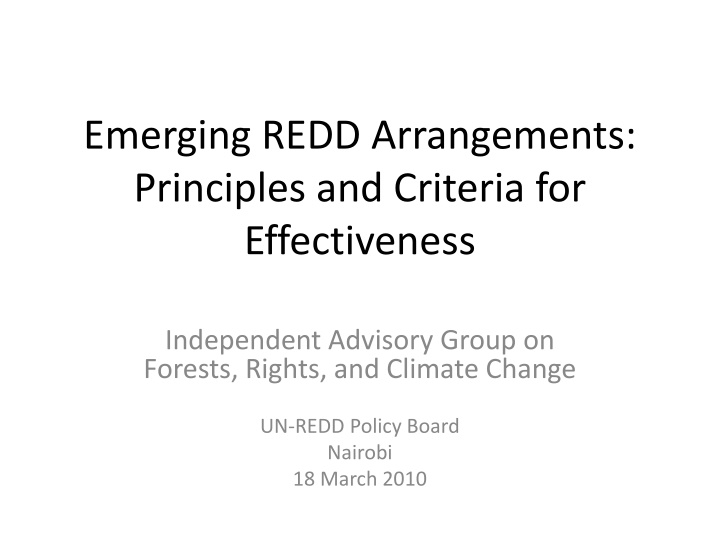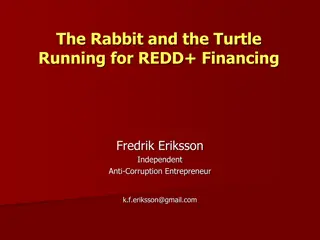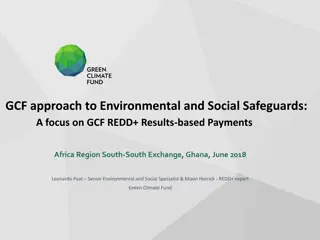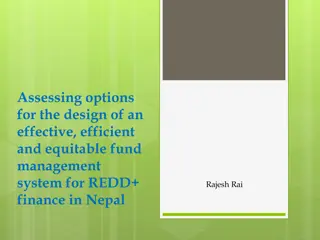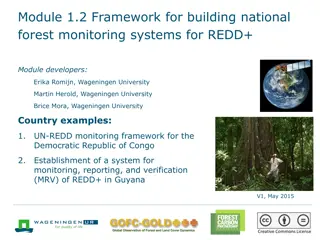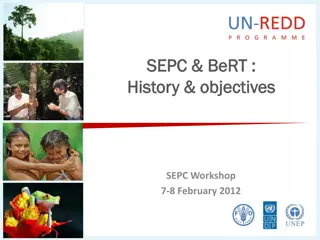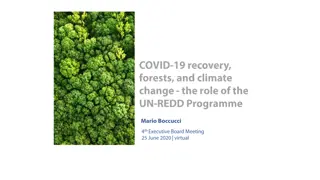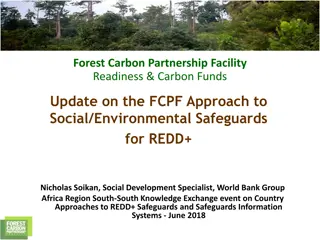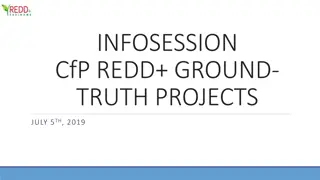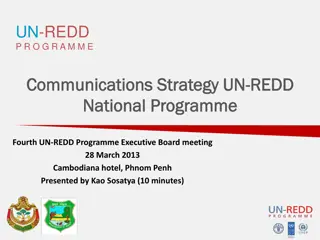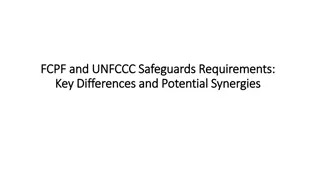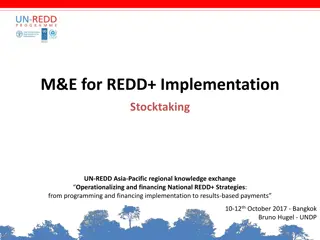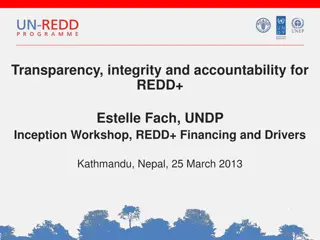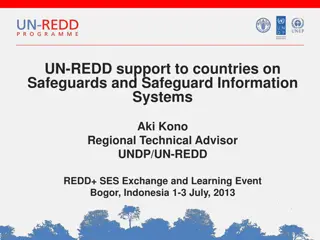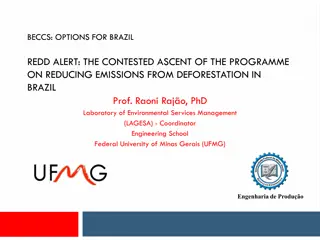Emerging REDD Arrangements: Principles and Criti
This document discusses the current state and stakeholders' interests in emerging REDD arrangements, including principles and criteria for effectiveness. It covers the implications, issues, and tasks ahead, as well as the governance and operations of the proposed architecture. The content also explores the readiness implementation of UNREDD and FCPF, along with emerging institutional scenarios and components of the global REDD architecture.
Download Presentation

Please find below an Image/Link to download the presentation.
The content on the website is provided AS IS for your information and personal use only. It may not be sold, licensed, or shared on other websites without obtaining consent from the author.If you encounter any issues during the download, it is possible that the publisher has removed the file from their server.
You are allowed to download the files provided on this website for personal or commercial use, subject to the condition that they are used lawfully. All files are the property of their respective owners.
The content on the website is provided AS IS for your information and personal use only. It may not be sold, licensed, or shared on other websites without obtaining consent from the author.
E N D
Presentation Transcript
Emerging REDD Arrangements: Principles and Criteria for Effectiveness Independent Advisory Group on Forests, Rights, and Climate Change UN-REDD Policy Board Nairobi 18 March 2010
Outline 1. Current state of play: (1) readiness funds and emerging institutional scenarios, (2) elements of a global REDD architecture, and (3) realities of the forest context 2. Stakeholders and rightsholders interests and expectations 3. The Principles and Criteria used to judge proposed architecture, interim arrangements, operations, governance 4. Implications, issues and tasks ahead 5. Discussion
State of Play: Readiness Implementation UNREDD and FCPF: opportunity to set positive precedents; made some progress in terms of representation and attention to governance Each has strengths/weaknesses, abilities to perform (thematic, geographic), and institutional mandates; competition is not all bad! Mixed records: on following own guidance and slow to disburse Internal bureaucratic hurdles; forestry still seen as high risk in World Bank Mixed record on standards, safeguards, recourse mechanisms, and progress still slow in aligning with higher international legal standards: 1. UNREDD has standards but no safeguards, beginning to build recourse mechanism, and still to operationalize IP guidance note 2. FCPF has safeguards and recourse mechanism, but are under pressure/trend to weaken them. SESAs have no teeth and therefore no clear guidance. 3. Without safeguards : no clear goalposts (long-term objectives) or mileposts (progress towards objectives)
State of Play: Emerging Institutional Scenarios Some scenarios emerging outside UNFCCC process: 1. Start a new light secretariat to begin the coordination by identifying most urgent needs, financial flows, existing actions and available resources. 2. Merge UNREDD, FCPF, FIP, CBFF to constitute the REDD Body 3. Keep all implementing organizations separate, but put under one Governing Board with independent advisory The idea is: to manage REDD readiness funding in anticipation of eventually becoming part of a global REDD architecture and transition from current fragmentation to coherent system under COP The question is: how do IP, forest peoples and developing countries view these scenarios?
Four Components of Architecture Global and National Levels Administrative Body Governance (Manage funds, registry and MRV (Board/Advisory) How to achieve accountability efficiency effectiveness justice & equity transparency Information and Monitoring Systems Operations (Payments and Standards) (MRV of carbon and governance)
State of Play: Reality of the Forest Context 1. Commodity boom back, opportunities and incentives to convert forests increasing - very difficult to change BAU 2. Legal and political precedents set guaranteeing IP and forest peoples rights to land/forests/carbon. Representation and participation in policy decisions result of decades of struggle 3. Major risk of conflicts as the value of land/forests/carbon increase and expectations of rights are not met (combustible combination, volatile mix of more money, great expectations, less governance)
Stakeholder Interests/Objectives Developing country governments Just and equitable compensation for contributions Financial and technical support Developed country governments/donors Investment integrity Measurable reduced emissions Functioning market for forest carbon Forest peoples, IPs, rights holders Rights respected and livelihoods enhanced Just and equitable compensation for contributions Equitable and participatory governance Private investors Return on investment Clear rules and low transaction costs Confidence in market Civil society Real reductions and protection of natural forests Enhanced social and economic development Protection of vulnerable and marginalized communities
Analysis of Stakeholder Interests Lots of overlap, and many mutual interests, But some important differences, and all put emphasis on different dimensions; All interests are legitimate and principles and criteria for design and operations need to reflect and address all of them
Interests/Objectives Give Rise to Principles Justice and equity in participation and payments Developing country governments Transparency in design and operations Transparency in administration and payments Developed country governments/donors Efficient and effective scheme Clear rules of the game Justice and equity Forest peoples, IPs, rights holders Accountability of administration Transparency of implementation Participation in decision making Effective emissions reductions Private investors Transparency Accountability Effectiveness (avoiding perverse incentives) Civil society Justice, equity and accountability Participation in decision making Transparent and accessible information and systems on financial flows, MRV
Principles give Rise to Criteria Balanced participation in decision-making bodies Developing country governments Adequate, predictable and sustainable compensation for changing BAU Accountable administrative systems Developed country governments/donors Performance-based payments Recourse mechanisms Enforceable rights (eg, FPIC, UNDRIP ) Forest peoples, IPs, rights holders Recourse mechanisms nationally and globally Transparent and accessible MRV and payment systems Equal participation of IPs, forest peoples in decision-making bodies Certification of emissions reductions Private investors Transparent and clear decisions and MRV Clear legal environment (secure property rights, contract enforcement) Forest conversion not rewarded by REDD+ programs Civil society Rights respected and contributions recognized and rewarded Equitable participation in decision-making by IPs, CSOs MRV measures more than carbon and is accessible for 3rd party verification Recourse mechanisms exist and are functional
Foundations for Effectiveness: Principles and Criteria Applied Ensure equitable representation, Ensure interim and permanent Administrative Body administrative organizations meet highest level of social, environmental and financial standards Governance transparency, independent advisory and audit for global and national-level institutions (Manage funds, registry and MRV (Board/Advisory) OUTCOMES Carbon sequestered & maintained Rights respected Livelihoods supported Forests conserved Information and Monitoring Systems impacts, in addition to carbon, ensure transparent, easy access to data Monitor social and environmental Operations and just, fair, social and environmental protections, and recourse mechanisms Ensure real drivers are targeted (Payments and Standards) (MRC of carbon and governance)
Implications for each Architectural Component Governance global and national Design representation of executive board (profile, role of governments, IP s and CSOs) Establish independent oversight and auditing mechanism (functions and roles of governments, IP s, CSOs) Administration ( Interim Financial Arrangements ) Apply Principles and Criteria to different options: which is optimal in terms of efficiency, transparency, accountability, etc what are advantages, disadvantages of different current entities (UNREDD, FCPF, FIP) how to maintain the highest-level standards? Operations: Establish operational guidance for environmental and social protections, progress, recourse MRV: Establish oversight and independent review systems at national and global levels
